Focusrite Vocaster Two Studio Kit Live Review by Jay The Engineer!
Back in August 2022, I had the opportunity to give a talk in Podcast Movement Dallas 2022 and met with Focusrite Team!
They're kind enough to send me a Focusrite Vocaster Bundle for review and giveaway!
Hence, I will be giving this unit away to the winner of my next notepd challenge!
Focusrite has been in the industry since 1985 founded by one of the greatest audio inventors, Rupert Neve! They have been a pro audio player until 2011, they launched the Focusrite Scarlet 2i2, an entry-level semi-pro audio interface. Then they saw the niche in Podcasting after Rode's success in consumer and podcasting products.
Now, fast forward to 2022, Focusrite finally released the first ever product that caters to podcaster, The Vocaster!
I will be reviewing it right here, and I did a live, raw, and uncut video review as well! You can watch it here!
https://www.twitch.tv/videos/1587428587
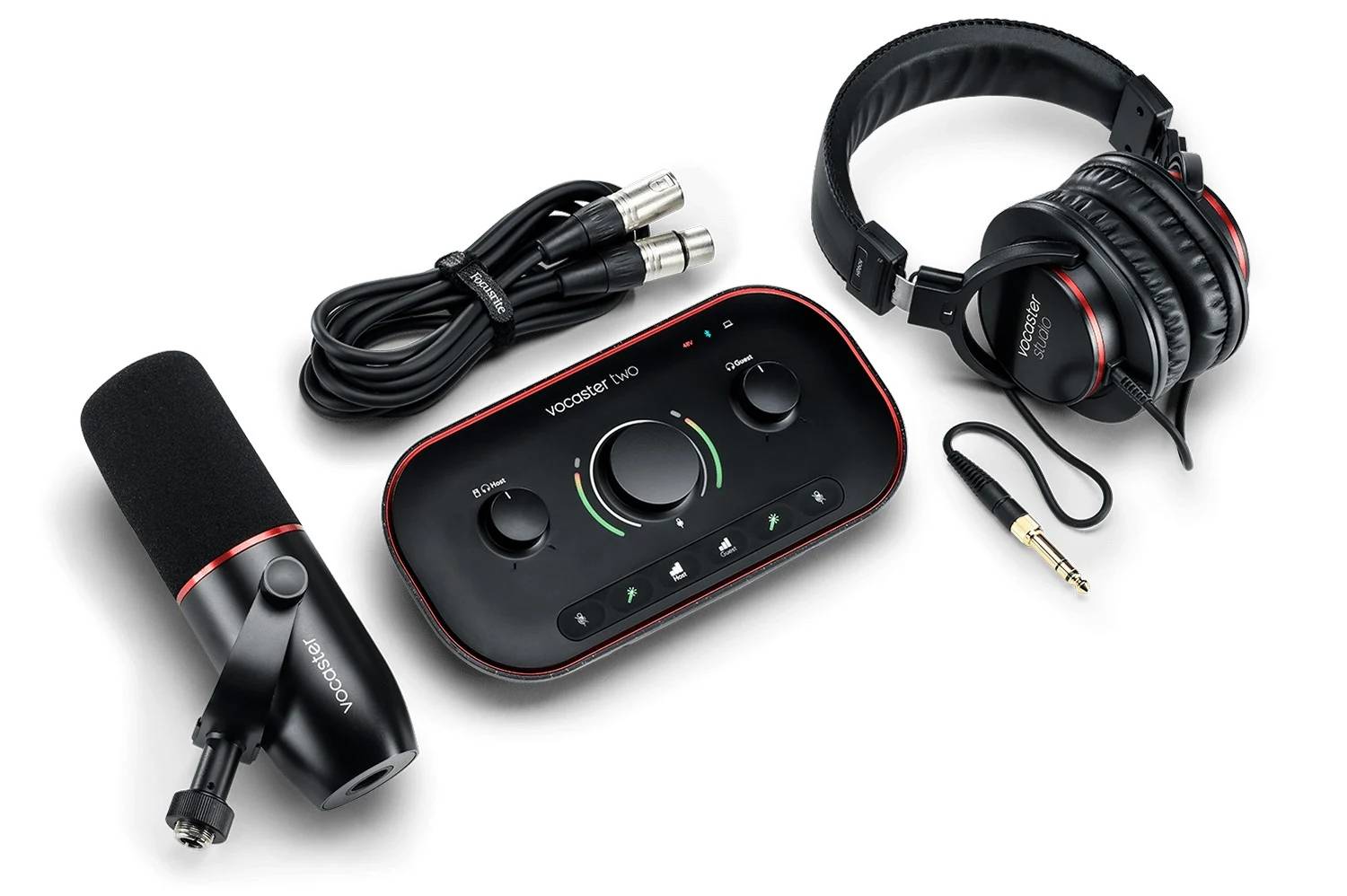
- Enhance Button
- Comes with four presets: clean, warm, bright, and radio
- Unfortunately, as I mentioned before, this is not something that I would use, and I also suggest people try to avoid using them if possible. You want to record your audio as raw as possible so you could edit them however you like, or sweeten them in the post. If you apply any during the recording, you risk not being able to reverse the effect if you don't like them.
- Auto Gain
- You engaged it by pressing and holding down the big knob in the middle until the white LED ring lit up, and you have 10 seconds to speak into your microphone. Once the countdown is done, it will automatically set your microphone gain.
- Also, a great feature that I will not use. Because before during sound check, no one is giving their 100%. Taping a podcast is putting up a performance, you will get more energy as you roll, and you might laugh out loud because you or your guest said something funny. Using the Auto Gain might risk distorting the preamp without you realizing it. However, if you still want to use the Auto Gain function, you should bring down your microphone phone 1 or 2 dB once it's set.
- Bluetooth Connection!
- This is a great feature, I don't think there are a lot of audio interfaces out there that could do this. This is great if someone can only do a phone interview and is not able to use Zoom or any remote recording software. Also, don't get me wrong, iPhone itself does has a pretty decent microphone built into it!
- Phone Connection!
- Again, another great feature! Not a lot of audio interfaces out there do this, but it's definitely great to have! There are still people out there who would only be able to do phone interviews and not any kind of remote platform interview!
- The Mute Buttons!
- I consider this as a feature because I do think every audio interface manufacturer out there should implement this simple button or ways to mute the microphone while having a clear indication that the channel has been muted!
- Constant Direct Monitoring
- I consider this as a feature as well because I don't think any audio interfaces out there (at least that I have used before) have them, however, there are pros and cons with this.
- The pro is that, you don't have to worry about finding ways to listen back to yourself, or if you're recording in a DAW, or doing Livestream, you don't have to worry about finding ways to route so you could hear your guest or yourself.
- The con is that anytime you are editing with Vocaster Two, you have to make sure you mute all the microphones so you're not confusing yourself with any sound that comes through the microphones.
- Power Button!
- I know this seems like a small thing, but it's important to have a power button! People love leaving their computers on 24/7, so having a button is great! You can restart your device easily without having to unplug and plug in the USB cable, and I can turn it off when I am not using it!
- It seems like Streamlab OBS and OBS don't natively support Vocaster. When I was trying to set up a live stream, I could not get a signal into Streamlab OBS and OBS, however, I could get a signal in Pro Tools and my computer itself. I ended up setting the Vocaster up in Nvidia Broadcast and using Nvidia Broadcast in my Streamlab OBS and OBS as my audio device to get the signal from Vocaster.
- This could be me, it sounds like there is a delay or buffer between I speak and I hear it back in my headphone. My guess is because of the "Enhance" function, maybe they are some DSP (Digital Signal Processing) built into the Vocaster, and that cause a delay in listening back to yourself. However, the delay is not terrible, if you are just a regular user, you might not realize it, or you might not know what to look for. *Some software like Pro Tools or Logic Pro let you change the buffer size which would result in hearing back yourself with a delay while conserving the computer's performance.
- I love the form factor, having the controls on the top panel should be the norm for all the audio interfaces!
- This is my favorite feature: The Mute button! Such an easy but essential tool to have on every audio interface.
- Having the headphone outputs in the front of the unit!
- Haven't felt knobs that were so smooth and satisfying!
- Having a power button!
- Amazing price with a great value at $499!
- The Big Knob! Sometimes, it's confusing just having one knob that does multiple things. I get it, it's cool, it's the digital age, and it saves some space. But, if I want to adjust my control very quickly or try to save time troubleshooting, having two different microphone gain knobs would be so much better!
- The "Enhance" Button. Personally, I would never use it unless it's a special effect button like Reverb, Moster Sound, or Ghost Sound that you could use creatively in content than just a regular "Enhance Button". Also, I think people should avoid the button, because, as I said, you want to record every raw.
- The Rubber strip that house the buttons and the rubber loop at the bottom of the device. Not a fan of rubber of any kind (on audio interfaces). They wore out, they break, they fell out and they generally don't last very long.
- I know the Vocaster Hub is just companion software, and it does have its perks like mixing, choosing presets, and all. But I would rather have an audio interface that could do all of the things that it needs to be done outside the box. While I am recording, I am not going to pull up another window just to mess around with the settings.
1. Vocaster DM14V microphone built quality.
Let's do a quick look at the Microphone, Vocaster DM14V!

I love the build of the microphone. It has a metal body, it felt solid and heavy, and the microphone body mount is great! You can spin the microphone after being mounted on a stand without having to detach the mount! Also just like the Shure SM7B the DM14V has a secured windscreen. Unlike the Shure MV7, I lost the windscreen due to how loose it is. On top of that, the DM14V has a really secured XLR connection! On any XLR microphone, I am looking for the "Click" sounds when you're connecting a cable into the microphone.
For the Vocaster DM14V built quality, 9/10.
2. How does the Vocaster DM14V sounds?
First off, how a microphone sound is purely personal. Someone might like how microphone A sounds, and some would prefer microphone B. For this, it's purely based on my opinion and how my ear perceived it.
My first impression of the sound that came through my headphone via DM14V is that it's not as smooth and warm as a Shure SM7B with or without the Cloudlifter. There is some harmonic distortion in the midrange (frequencies) of the microphone.
(How harmonic distortion sounds to me is that I heard some sort of distortion in the midrange (frequencies) while the bass and the treble sound pretty intact.)
However, this doesn't mean that the microphone isn't good. But compare to SM7B and if you have the budget, you should go with SM7B, if not, DM14V sounds pretty good too! Definitely better than the Blue Yeti!
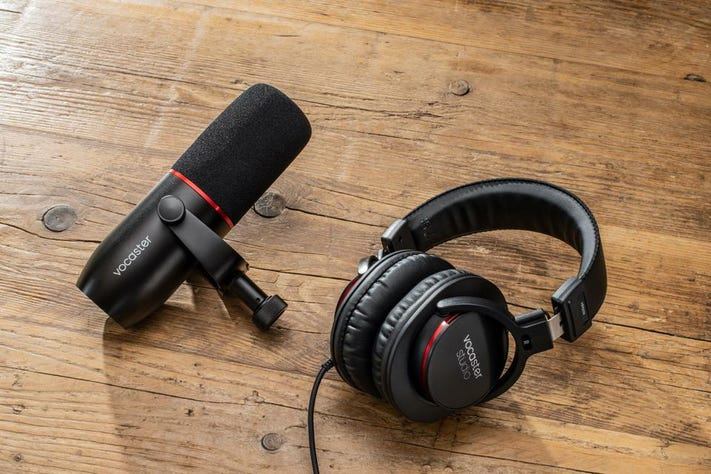
For the Vocaster DM14V sound quality, 7/10.
3. Vocaster Two's Connectivity!
Now to the main attraction, the Focusrite Vocaster Two! This would be mainly about the audio interface!
Vocaster Two looks like a simple device, however, it's packed with multiple connectivities that outshine some of the audio interfaces out there!
First off, at the back of The Vocaster, there are two XLR microphone inputs at the back of the device, pretty standard connectivity (was hoping for a combo, but since it caters towards podcaster, regular XLR connect seems reasonable), a pair of 1/4" balanced output for speakers (podcaster might not use these often unless you're editing or listening using your speakers), a 1/8" TRRS input for a phone connection, a 1/8" line output for camera or a backup recorder, a Bluetooth connection, a USB-C connection that you could connect to either the computer or iPad/iPhone and two 1/4" headphones output at the front of the device!
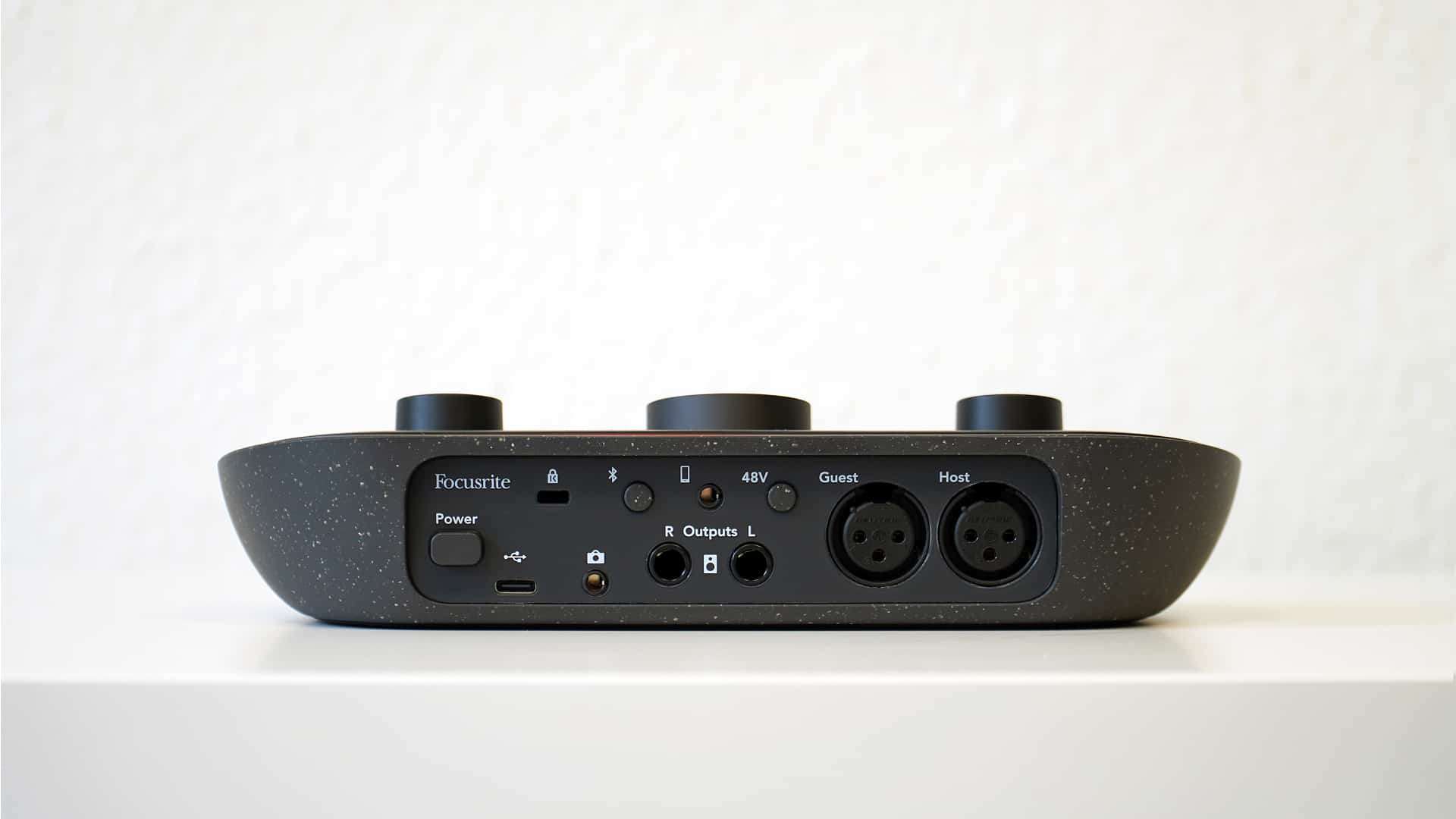
Having headphones output at the front of the device is also another great decision made by Focusrite! It's easy to access since you have to unplug and plug in your headphone pretty often, and you don't have to move your device around just to plug in your headphone!
Vocaster's Two Connectivity, 9/10
4. Vocaster Two's Aesthetic
At a glance at the Vocaster Two, love that they build it as a top-facing audio interface rather than the rack mount type. That means, all the buttons and knobs are located at the top of the interface, which means, you can get to your control easily, without having to look at it!
Trivia: If I am not mistaken, this could be the very first top-facing audio interface that Focusrite built!
At first glance, it's a pretty good-looking device, and it looks exactly like a robot with the knobs looking like eyes and nose, and the buttons at the bottom look like teeth!
Unfortunately, the Vocaster has a plastic finish rather than a Metal Finish like its big brother Scarlett 2i2, which means it could break easily. The upside to that is that it's lighter and more portable compared to Scarlett 2i2, and down the road, it could be even cheaper than the Scarlett 2i2.
Edit: Just heard back from the Focusrite team, and they gave this statement:
There is a really good reason that it’s plastic and feels lightweight; it’s made from 50% recycled plastics which will increase over time to up to 85%. On top of that, all the packing materials are either compostable or recyclable. We’re doing what we can for the good of the planet.
Edit: Now that seeing the statement from the Focusrite team, I can get behind the plastic finish from recycled plastic! We gotta save the environment, and they're doing good for the planet!
The top panel of the Vocaster unfortunately is not fingerprint and grease resistant. So if you have a greasy hand or even a sweaty hand, it could leave a mark! Vocaster 2's labeling is also very accurate and easy to understand. There's a Bluetooth Icon, Computer Icon (which suggests the connectivity to your computer), and a 48V Icon (Phantom power, it will lid up when it's engaged!), Host and Guest icons long with headphones and speakers indicate which knobs control which channels' volume. This is an interesting choice by them, and also indicates that The Vocaster Series is definitely built with podcasters in mind. Normally, it would be labeled as Channel One or Channel, however, in The Vocaster Series, it was labeled as Host or Guest.
The bottom panel Vocaster is a strip of rubber that loops around it to prevent the device from slipping. It's a smart move! However, things with rubber are that, if it gets wet (especially with cold water), prolonged exposed to sun and heat, or constantly moving and rubbing against surfaces, it will eventually wear out, and started to fade! It's not bad if you set it up as a stationary device, however, if you're moving around a lot, like eating and drinking by your desk, and have sweaty hands, you might have to be careful using the device!
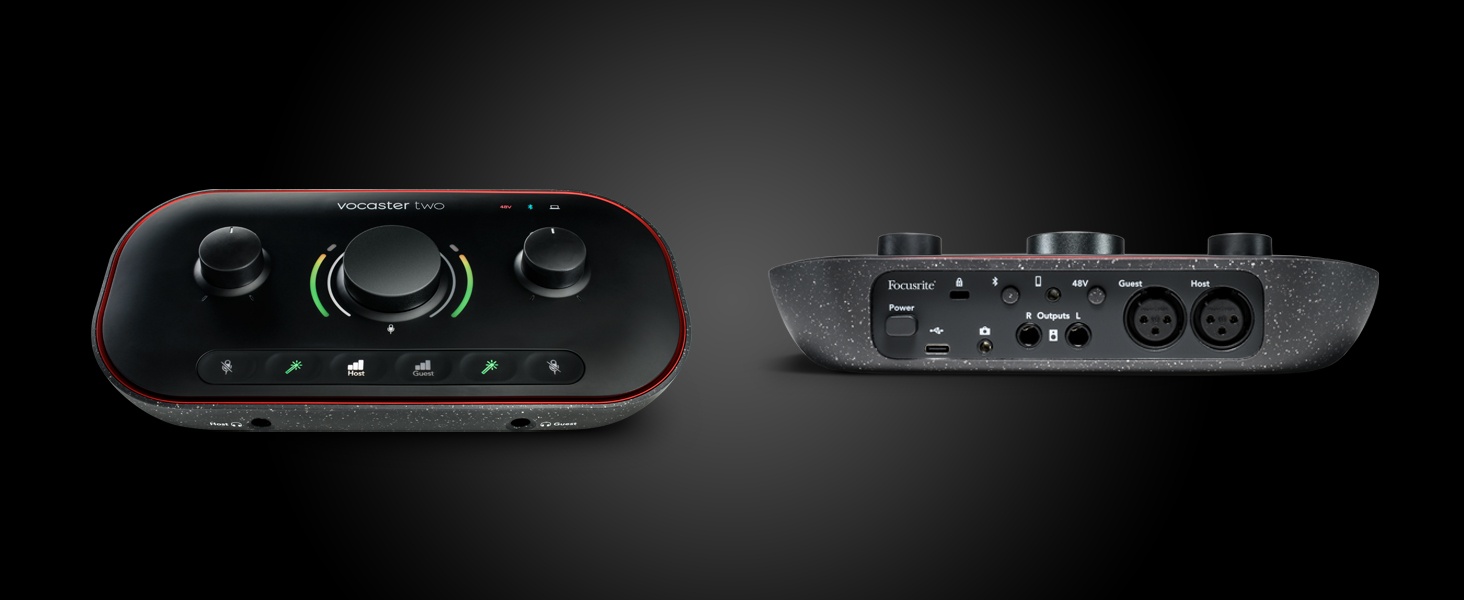
Also, last but not least, it seems like there are a lot of openings that weren't properly sealed. This is not a dealbreaker, but me just being picky or whatnot. When I was looking at the unit, I could see some LEDs from the opening of the XLR ports, which means, if you're not careful, water or things could easily get into the unit and potentially ruin the circuit board. If you have pets at home, you might have to be careful, or just plug in two XLR cables at all times.
Vocaster Two Aesthetic, 7/10
5. Vocaster Two's Knob Layout!
Now onto the layout! When you're buying or choosing a gear, you don't just look at its features, or how it sounds. You also have to look at the ease of use, the layout, the labeling, and how easy it is to access your controls.
Looking at the top of The Vocaster two, there are two small headphone volume knobs on both sides, one big knob (Digital Pot) at the middle, and a strip of buttons at the bottom which includes two mute buttons, two enhance buttons, and two channel-selector buttons.
Let's talk about them!
First off, a huge fan of mute buttons, It's smart that Focusrite decided to implement these buttons unlike most of the audio interfaces out there ( I am looking at you, SSL). My guess is that it was supposed to be a cough button, but it's still a genius move and important especially since The Vocaster has a constant direct monitoring function (We will get to that later).
All the knobs felt amazing, the resistance of the pots is just right that you won't accidentally bump them and it changes your value too much, and they are not too tight that it requires some force to turn them. The knobs on both sides control the headphones for the host or guest and the middle big knob control the microphone gain depending on which channel has been selected. The middle big knob also has a special feature that comes with it that is called "Auto Gain". When you have selected either "Host" or "Guest", you press and hold down the big knob until you see the white ring of LED lid up, it will act as a 10 seconds countdown. During such time, you can speak into the microphone of such channel, I would suggest just talking about what you had for breakfast, lunch, or dinner. Once the timer is up, it will automatically set your microphone gain based on your volume! I think it's a great feature, however, again, not a feature that I would use.
There's a ring of LED around the big knob, and then two more on each side of the knob. The inner LED strip indicates the microphone gain which is shown in White, and when a channel was muted, it will turn red to indicate the microphone has been muted, which I think it's a great feature!
I have had issues with some other audio interfaces where the mute status wasn't clearly indicated and it took me forever to troubleshoot them. This will save anyone a lot of time while troubleshooting. The outer two LED strips show the audio signal's metering. However, a couple of things that I wish they couldn't do better with them are labeling them with numbers in dB (decibel), this could be helpful while troubleshooting with a remote producer, turning up the brightness on those LEDs, and having a longer peak hold time so you could really tell where's your signal at. Right now, I am not mistaken, the peak hold time on the two metering LEDs is too fast to almost non-existence, it would be great if they could change it to maybe 50 ms to 100 ms.

Vocaster Two's Knobs, 8/10
6. The Strips of Buttons!
Now on to the strip of buttons that look exactly like a robot's teeth if it has one!
There are six buttons on the strip, two mute buttons, two enhance buttons, and two-channel selectors buttons between "Host" and "Guest". The strip of buttons has a rubber finish, which allows you to quickly navigate to the control that you wanted just by touching it. However, it's not my favorite. As I mentioned previously, having a rubber finish on any button is a bad idea, because they fade easily especially if you use them often. Depending on the temperature of your room, or if you accidentally spill anything on it, it will get ruined.
Those buttons are pretty self-explanatory, the mute buttons (or some might call it a cough button) mute the microphone if engaged, the enhance buttons (which come in four different presets: clean, warm, bright, and radio.) when activated, it will apply one of those four presets that you have selected in the software, and the Host/Guest buttons, which when selected, you can use the big knob in the middle to adjust your microphone gain.
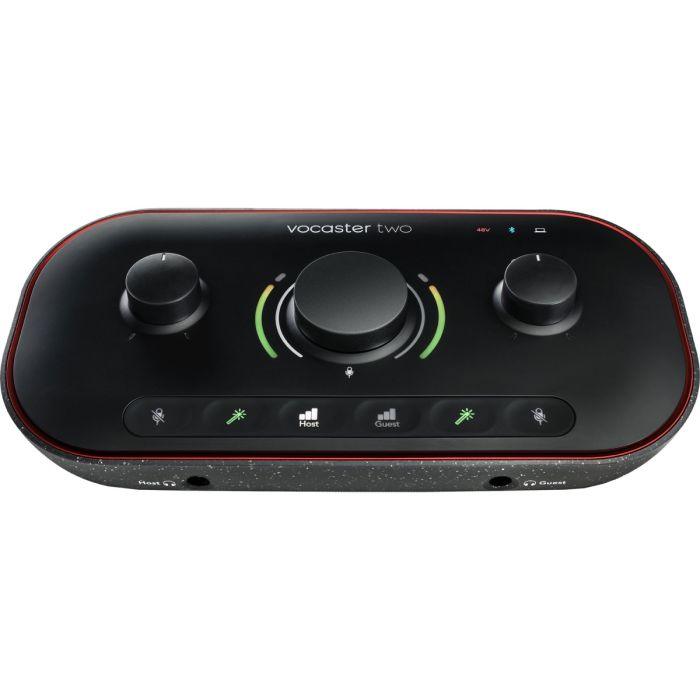
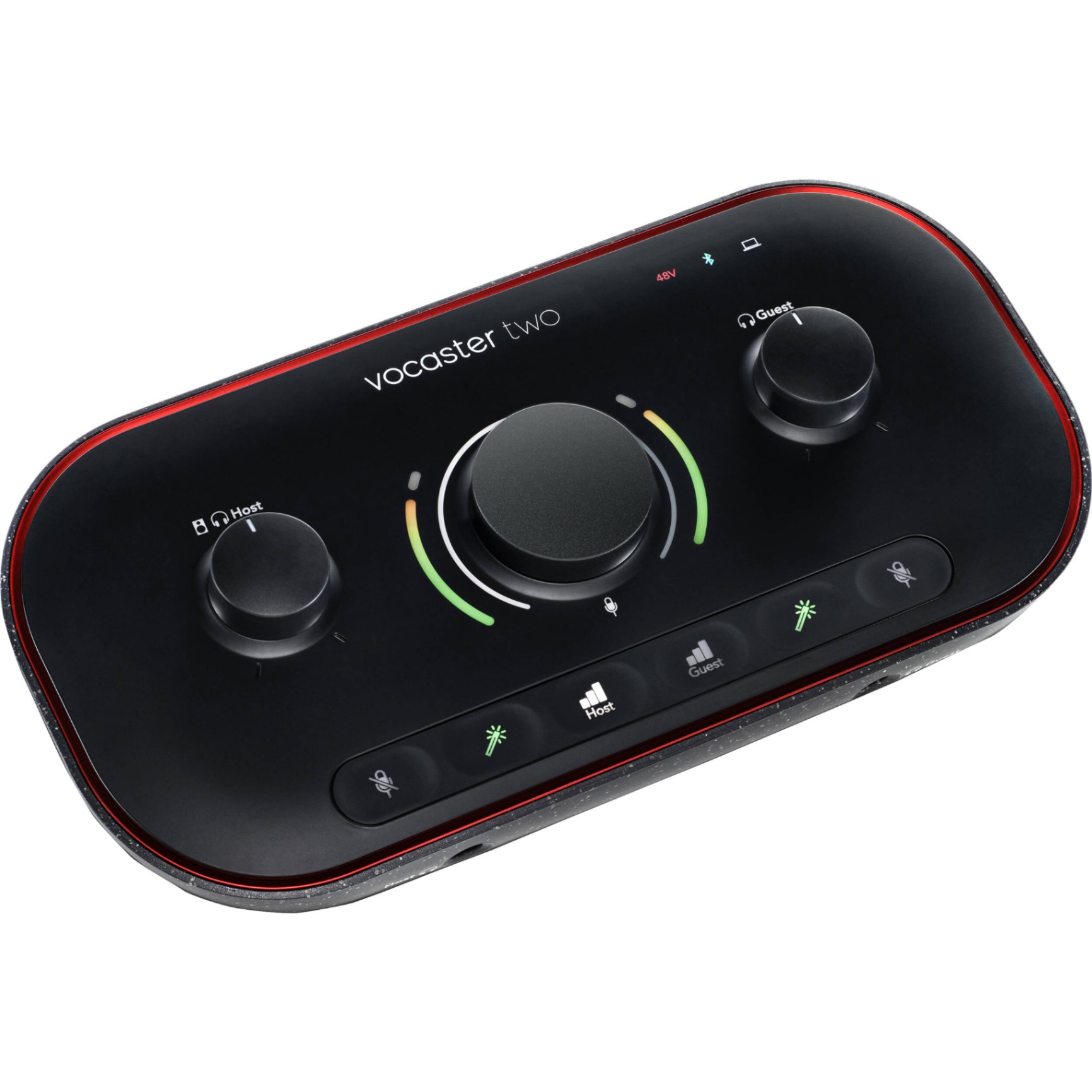
Vocaster Two's buttons, 5/10
7. The Features!
So, now that we all know what the knobs and buttons do, let's look at Vocaster Two's features.
I will list some of the features that have been advertised by Focusrite already, and also some that I think it's a features that not a lot of other audio interfaces have, but are not advertised by Focusrite, and then write how I feel about them.
Considering there are some features that I won't use or avoid using, I am giving this a 6/10.
8. Some weird things occurred when I do the review.
There are some weird things that popped up here and there while I was doing the review.
9. My Love Hate relationship with Vocaster Two
A quick summary of what I like and don't like about Vocaster Two!
What do I like about Vocaster 2 Studio Kit?
What they could've done better!
10. Final Thought
So what do I think about The Vocaster Two Studio Kit you asked?
I still think it's a great product despite all the small annoyances that might annoy me. However, one man's treasure is someone else poison! I have used countless audio interfaces in my audio life, and I still buy some obscure audio interfaces to try out, so I personally have a high standard when come to audio interfaces. It's not just about how they sound, it's also about how rugged they are and how well was the user experience while using them.
It's a great product, it has great features that you might not get somewhere else with the same price range, and the Studio Kit? Definitely worth the money! SM7B alone cause $400, and a two-channel well designed and reliable audio interface would cost you around $150, not to mention buying all the cable and headphones!
So overall, I give Focusrite Vocaster Two Studio Kit an 8.5/10!
Also, if you read it this far, here's the challenge to Win the Vocaster Two Studio: https://notepd.com/challenge/posts/win-a-focusrite-vocaster-two-studio-kit-s9pit
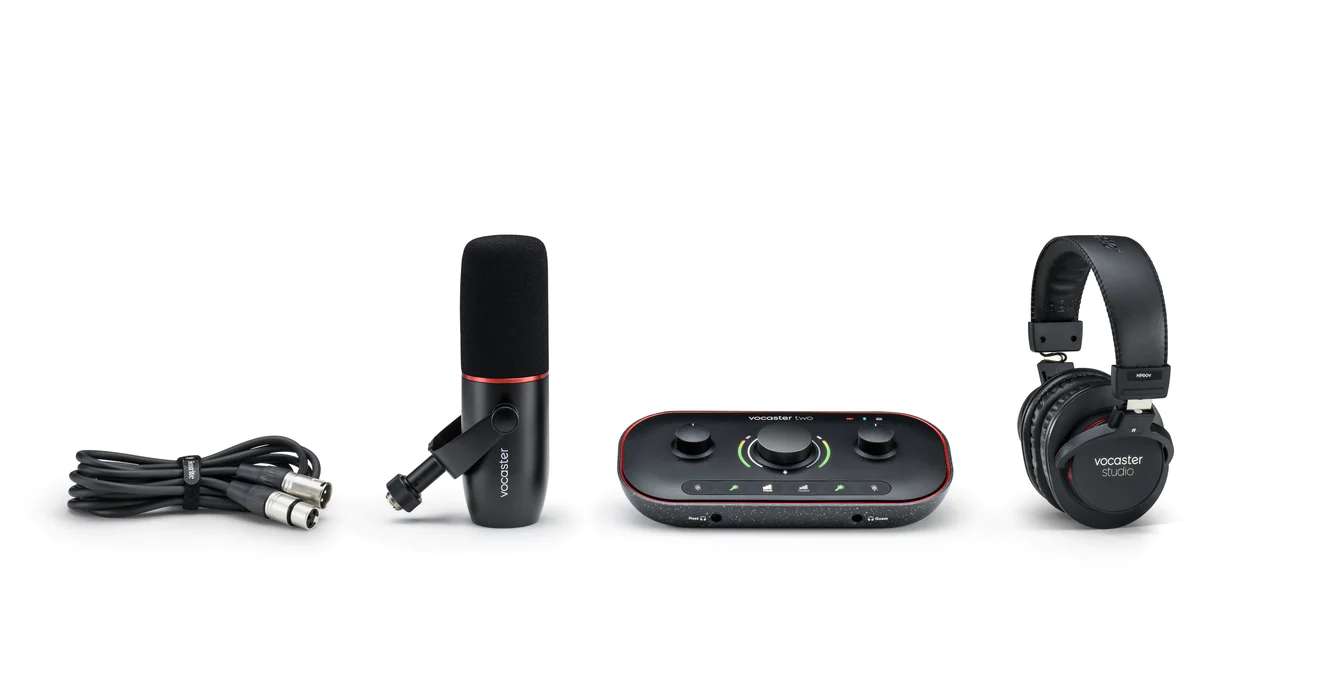

No comments.